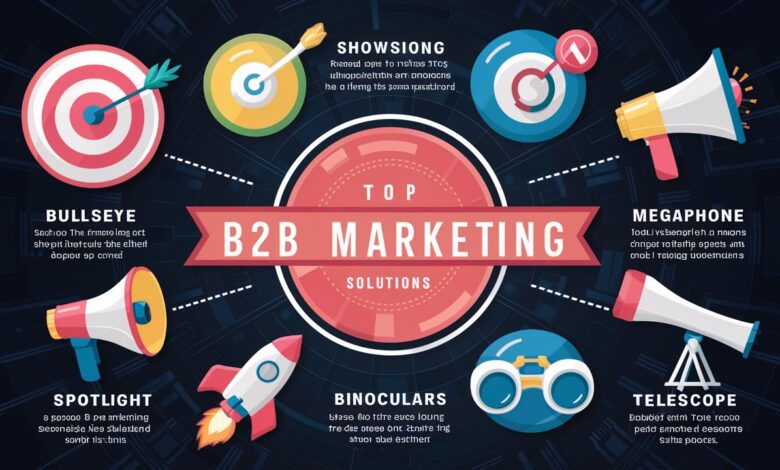Top 8 B2B Marketing Solutions for Increased Brand Visibility

In today’s competitive business landscape, brand visibility is crucial for success. Whether you’re a startup or an established business, the ability to stand out and be recognized by potential customers can make all the difference. This is particularly true for B2B (business-to-business) companies, which rely on a different set of marketing strategies to connect with other businesses and stakeholders. So, how can B2B businesses increase their brand visibility and, in turn, drive more leads and sales? In this blog, we’ll explore top B2B marketing solutions that can help boost your brand’s presence and elevate your marketing game.
Why Brand Visibility Matters for B2B Companies?
Brand visibility is essentially the extent to which your business can be seen and recognized by your target audience. For B2B companies, it’s not just about attracting attention; it’s about building trust and authority in your industry. Increased brand visibility can:
- Drive more traffic: Potential customers will discover your business more easily.
- Increase credibility and trust: Consistent brand exposure fosters trust with potential partners and clients.
- Generate more leads: Visibility leads to more opportunities to nurture leads and close sales.
For B2B businesses, where trust and relationship-building are essential, ensuring your brand is front and center can create a significant competitive advantage.
Top 8 B2B Marketing Solutions to Increase Brand Visibility
When it comes to enhancing brand visibility, B2B companies need to leverage a combination of traditional and digital marketing strategies. Below are some of the most effective B2B marketing solutions that can help you stand out in the crowded marketplace.
1. Content Marketing and Thought Leadership
Content marketing remains one of the most effective ways to boost brand visibility in B2B sectors. Publishing high-quality, informative content on a regular basis can position your business as an industry leader and attract the right audience. Here’s how you can use content marketing to your advantage:
- Create Educational Blog Posts: Share industry insights, product information, and tips that help your audience solve problems.
- Publish Whitepapers & Ebooks: These in-depth resources allow you to dive deep into subjects that matter to your audience, offering more value and enhancing credibility.
- Guest Blogging and Collaborations: Write guest posts on reputable platforms within your industry. This not only boosts visibility but also introduces your brand to a wider audience.
A great example of B2B content marketing is the oil and gas marketing agency, which often publishes detailed reports and insights about the oil and gas industry, establishing themselves as thought leaders. Such initiatives help businesses in niche industries like oil and gas stay top of mind for clients and potential partners.
2. Search Engine Optimization (SEO)
In today’s digital world, SEO is essential for any company that wants to boost brand visibility online. With a well-executed SEO strategy, your website can appear higher on search engine results pages (SERPs), which drives more organic traffic. Here’s how you can improve your SEO:
- Keyword Research: Understand what your potential customers are searching for and target those keywords on your website and in your content.
- On-Page SEO: Optimize your website’s content, meta descriptions, titles, and images to make it more search engine friendly.
- Off-Page SEO: Build backlinks from high-authority websites within your industry to improve your site’s credibility and visibility.
For example, an oil and gas marketing agency would want to focus on ranking for keywords such as “B2B oil and gas marketing strategies” or “oil and gas digital marketing.” This can ensure they attract the right clients who are searching for these specific services.
3. Social Media Marketing
Social media platforms provide an excellent opportunity for B2B companies to increase brand visibility and engage with their audience. While social media may be more commonly associated with B2C marketing, it’s equally powerful for B2B. Here’s how to use social media effectively:
- LinkedIn: As a professional networking platform, LinkedIn is essential for B2B marketing. Regularly post industry insights, case studies, and company news to stay visible among decision-makers.
- Twitter: Use Twitter to share updates and engage in real-time conversations about industry trends and news.
- Instagram and Facebook: Though more commonly used in B2C, these platforms can also help B2B companies humanize their brand and showcase behind-the-scenes content or client testimonials.
Consistent, thoughtful engagement on social media can help you stay top of mind and increase brand visibility. By sharing helpful content, engaging with others in your industry, and promoting relevant updates, you can create valuable connections that drive business growth.
4. Email Marketing Campaigns
Email marketing is another powerful B2B marketing solution that offers opportunities for direct, personalized communication with your audience. Here’s how to leverage email marketing:
- Nurture Leads: Use email campaigns to nurture leads and stay connected with potential clients. Share valuable content such as whitepapers, case studies, and blog posts.
- Segment Your Audience: Tailor your messaging based on audience interests, pain points, and behavior to increase engagement and conversions.
- Newsletter: Consistently send out newsletters with company updates, industry news, and expert insights to keep your audience engaged and informed.
An oil and gas marketing agency might use email campaigns to share quarterly industry reports, news, and event invitations with their clients, helping to increase brand visibility and maintain strong relationships.
5. Paid Advertising
While organic strategies are essential, sometimes paid advertising can offer a quicker boost to your brand’s visibility. Some paid advertising options include:
- Google Ads: Invest in pay-per-click (PPC) campaigns targeting high-intent keywords that potential clients might search for.
- LinkedIn Ads: As a platform specifically designed for professionals, LinkedIn offers targeted advertising options that can help you reach decision-makers in your industry.
- Display Ads: Use display ads across relevant websites within your industry to increase brand recognition.
By strategically placing ads where your target audience spends time, you can ensure your brand gets noticed and drives traffic to your website or landing page.
6. Webinars and Virtual Events
Webinars and virtual events have gained massive popularity in recent years as a way to connect with potential clients and prospects in real-time. These interactive sessions allow you to showcase your expertise, engage with your audience, and increase brand visibility. Here’s how you can incorporate webinars into your marketing strategy:
- Industry Topics: Choose topics that align with your audience’s interests and provide them with valuable insights.
- Invite Guest Speakers: Partner with industry influencers or experts to co-host webinars, which can expand your reach and credibility.
- Promote Events: Share your webinars through email campaigns, social media posts, and even paid ads to maximize attendance.
For example, an oil and gas marketing agency could host a webinar on the latest trends in energy marketing, offering valuable insights to industry professionals. This helps not only with visibility but also positions the agency as an authority in its field.
7. Influencer and Partner Marketing
In the B2B space, partnering with industry influencers or other businesses can dramatically increase your brand visibility. You can collaborate with influencers or complementary businesses to create joint campaigns, cross-promote content, and even co-host events. This type of marketing helps you tap into new audiences that you may not have access to otherwise.
8. Analytics and Continuous Improvement
Finally, it’s essential to measure the success of your marketing efforts. By using analytics tools, you can track website traffic, social media engagement, lead conversions, and more. This data can provide valuable insights that help you refine your strategies and improve overall brand visibility.
Some popular analytics tools include Google Analytics, HubSpot, and SEMrush. Regularly reviewing your marketing efforts ensures that you’re on the right track and allows you to make necessary adjustments in real-time.
Conclusion: Crafting a Comprehensive Strategy
Increasing your brand visibility in the B2B space is not about relying on a single marketing solution. It’s about combining several strategies and tools to create a holistic approach that consistently positions your business in front of your target audience. From content marketing and SEO to social media engagement and paid advertising, the solutions outlined in this post provide practical, actionable ways to boost your brand visibility.
As you implement these strategies, remember that visibility is not a one-time effort. Consistency, quality, and authenticity are key to building long-term brand recognition. Whether you’re working with a B2B marketing solutions provider or handling it in-house, the goal should always be to create value and foster relationships that ultimately help your business grow.




